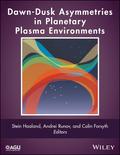Dawn-Dusk Asymmetries in Planetary Plasma Environments
Geophysical Monograph Series (Series Nr. 1)

1. Edition December 2017
376 Pages, Hardcover
Wiley & Sons Ltd
DawnDusk Asymmetries in Planetary Plasma Environments
Dawn-dusk asymmetries are ubiquitous features of the plasma environment of many of the planets in our solar system. They occur when a particular process or feature is more pronounced at one side of a planet than the other. For example, recent observations indicate that Earth's magnetopause is thicker at dawn than at dusk. Likewise, auroral breakups at Earth are more likely to occur in the pre-midnight than post-midnight sectors. Increasing availability of remotely sensed and in situ measurements of planetary ionospheres, magnetospheres and their interfaces to the solar wind have revealed significant and persistent dawn-dusk asymmetries. As yet there is no consensus regarding the source of many of these asymmetries, nor the physical mechanisms by which they are produced and maintained.
Volume highlights include:
* A comprehensive and updated overview of current knowledge about dawn-dusk asymmetries in the plasma environments of planets in our solar system and the mechanisms behind them
* Valuable contributions from internationally recognized experts, covering both observations, simulations and theories discussing all important aspects of dawn-dusk asymmetries
* Space weather effects are caused by processes in space, mainly the magnetotail, and can be highly localized on ground. Knowing where the source, i.e., where dawn-dusk location is will allow for a better prediction of where the effects on ground will be most pronounced
Covering both observational and theoretical aspects of dawn dusk asymmetries, Dawn-Dusk Asymmetries in Planetary Plasma Environments will be a valuable resource for academic researchers in space physics, planetary science, astrophysics, physics, geophysics and earth science.
Table of Contents
?List of contributors
Preface
Acknowledgements
Part I: External contributions to dawn dusk asymmetries Chapter 1. The magnetosphere of the Earth under sub-Alfvénic solar wind conditions as observed the 24th and 25th of May 2002.
E. Chané, J. Saur, J. Raeder, F. M. Neubauer, K. M. Maynard, S. Poedts
Chapter 2. Dayside magnetosphere response to solar wind pressure changes: propagation geometry and speed Brian J. Jackel, Konstantin Kabin
Chapter 3 . Magnetopause plasma parameters and asymmetries in solar indmagnetosphere coupling Brian Walsh
Chapter 4. Large-scale simulations of solar wind ion entry and dayside precipitation: dawn-dusk asymmetry, J. Berchem, R. L. Richard, C. P. Escoubet, S. Wing, F. Pitout
Chapter 5. Dawn-dusk asymmetries of the Earth's dayside magnetosheath in the Magnetosheath InterPlanetary Medium reference frame A. P. Dimmock, K. Nykyri, A. Osmane, H. Karimabadi, T. I. Pulkkinen
Chapter 6. Observed dawn-dusk asymmetries at the magnetopause, S. Haaland, H. Hasegawa, J. DeKeyser, L. Maes
Chapter 7. Dawn-dusk asymmetry and internal structure of the magnetopause, Johan De Keyser, Lukas Maes, Romain Maggiolo, and Stein Haaland
Chapter 8. On IMF-induced dawn-dusk asymmetries in earthward convective fast flows, Timo Pitkänen, Maria Hamrin, Tomas Karlsson, Hans Nilsson, and Anita Kullen
Chapter 9. Time-dependence of dawn-dusk asymmetries in the terrestrial ionospheric convection pattern Adrian Grocott
Chapter 10. The role of the upper atmosphere for dawn-dusk differences in the coupled magnetosphere-ionosphere-thermosphere system Matthias F¨orster, Eelco Doornbos, and Stein E. Haaland
Chapter 11. Surveys for 557.7/630.0-nm dayside auroral excitation in Ny-Ålesund, Svalbard and South Pole, Antarctica Ze-Jun Hu, Hui-Gen Yang, Yusuke Ebihara, Hong-Qiao Hu, Bei-Chen Zhang
Part II: Internal contributions to dawn-dusk asymmetries Chapter 12. Aspects of the morning/afternoon asymmetry of geomagnetic fluctuations at middle and low frequencies. Umberto Villante.
Chapter 13. Pre-midnight preponderance of dispersionless ion and electron Injections. C. Gabrielse, A. Runov, V. Angelopoulos, E. Spanswick, D. L. Turner
Chapter 14. Dawn-dusk (azimuthal, MLT) asymmetries in the ULF waves and their known and potential impacts on the coupled MI system, Jonathan Rae
Chapter 15. Spatial structure and asymmetries of magnetospheric currents Inferred from high-resolution empirical geomagnetic field models, M. I. Sitnov,G. K. Stephens, N. A. Tsyganenko, A. Y. Ukhorskiy, S. Wing, H.Korth B. J. Anderson
Chapter 16. A Review of Dawn-Dusk Asymmetries Observed Using the TWINS Mission of Opportunity Amy M. Keesee
Chapter 17. Dawn-dusk asymmetry of the appearance of low-latitude mantle plasma in the magnetotail observed by ARTEMIS Chih-Ping Wang, Xiaoyan Xing, T. K. M. Nakamura, Larry R. Lyons, and Vassilis Angelopoulos
Chapter 18. Dawn-dusk asymmetries in magnetotail transients A. Runov, S. Kiehas, and S. S. Li
Chapter 19. Pre-midnight preponderance of dispersionless ion and electron injections E. A. Kronberg, K. Li, E. E. Grigorenko, R. Maggiolo S. E. Haaland, P. W. Daly, H.Luo
Chapter 20. Dawn-dusk asymmetries in the auroral particle precipitation and their modulations by substorms Simon Wing, Jay R. Johnson, and Enrico Camporeale
Chapter 21. Dawn-dusk asymmetries of ionospheric outflow Kun Li, E. A. Kronberg, M. Andre, P. W. Daly1, Y. Wei and S. Haaland
Chapter 22. Conjugate Aurora Location During a Strong IMF By Storm William Longley, Patricia Reiff, and Antoun G. Daou, Marc Hairston
Chapter 23. Dawn-dusk asymmetries in auroral morphology and processes T. Karlsson, A. Kullen, G. Marklund
Part III: Dawn dusk asymmetries in other planets Chapter 24. Dawn-dusk asymmetries in Jupiter's magnetosphere B. Palmaerts, M. F. Vogt, N. Krupp, D. Grodent, B. Bonfond
Chapter 25. Local time asymmetries in Saturn's magnetosphere J.F Carbary, D.G. Mitchell, A.M. Rymer, N. Krupp, D. Hamilton, S.M. Krimigis, S.V. Badman
Chapter 26. Dawn-dusk asymmetries in Mercury's magnetosphere Torbjörn Sundberg
Andrei Runov, University of California, Los Angeles, USA
Colin Forsyth, University College London, U


